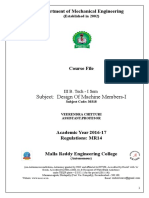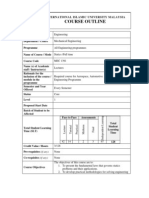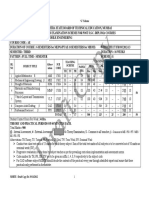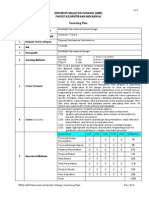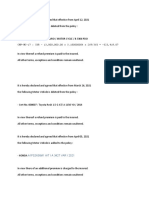Nba - Mec402 Ae
Nba - Mec402 Ae
Uploaded by
PethurajCopyright:
Available Formats
Nba - Mec402 Ae
Nba - Mec402 Ae
Uploaded by
PethurajCopyright
Available Formats
Share this document
Did you find this document useful?
Is this content inappropriate?
Copyright:
Available Formats
Nba - Mec402 Ae
Nba - Mec402 Ae
Uploaded by
PethurajCopyright:
Available Formats
Automobile Engineering [MEC 402]
KALASALINGAM UNIVERSITY
(Kalasalingam Academy of Research and Education)
Anand Nagar, Krishnankoil 626 126
DEPARTMENT OF MECHANICAL ENGINEERING
----------------------------------------------------------------------------------------------------------------------------COURSE PLAN
COURSE / BRANCH
: B.Tech. / MECHANICAL ENGINEERING
SEMESTER
: ODD SEMESTER (2015-16)
SUBJECT
: AUTOMOBILE ENGINEERING
CODE
: MEC 402
NAME OF THE COURSE COORDINATOR
: Mr. M. PETHURAJ
FACULTIES HANDLING
: Mr. G. S. SAMY, Mr. KALIRASU
YEAR / SEMESTER / SECTION
: IV / VII / A, C and SHIP
1. Pre-requisite:
Basic knowledge in Engineering drawing, Thermodynamics and I.C. Engines.
2. Course Objectives:
This Course aims to give the General Knowledge about an Automobile. This Course helps the
Students to learn the operation of various systems in a vehicle. The Course covers the Topics such as
classification of Vehicles and Engines, Engine components, Steering system, Wheels, Suspension
System, Transmission System etc and also provides basic knowledge about the Alternate energy
systems for a Vehicle.
3. Course Outcome:
Upon the successful completion of the course, the students should be able to
a) Describe the function of an automotive engine in terms of types, classification, operation
and construction as well as engine performance
b) Discuss the function of automotive engine systems such as steering system, suspension
system, fuelling system and braking system.
c) Explain and evaluate the function of the manual and automatic transmission, front and
rear drive axle and the four wheel drive system
d) Know the purpose of automotive electrical, electronic, HVAC (heating, ventilation and
air conditioning) System
e) Understand and apply the concepts of alternate Energy sources.
4. List of Text Book:
1. Heitner, J., Automotive Mechanics Principle and Practice, Affiliated East-West Press Ltd.,
2nd ed., 1974.
5. List of Reference Books:
1. Newton, K., Steeds, W., and Garrett, T.K., The Motor Vehicle, Butterworths, 1989.
2. Kirpal Singh, Automobile Engineering, Vol. I and II, Standards Publishers, New Delhi,
2000.
6. Web resources:
ww.conceptengine.tripod.com
www.keveny.com/Engines.html
www.howstuffworks.com
www.gm.com/automotive
Nptel.iitm.ac.in
1|Page
Automobile Engineering [MEC 402]
7. Lesson plan
Topic
No.
Topic Name
Ref. Books
No. of periods
Cumulative
Hours
10
12
14
16
19
20
22
25
27
29
33
35
37
39
41
43
44
45
Unit I-Engines
1.
2.
3.
4.
5.
6.
7.
8.
9.
10.
11.
12.
13.
14.
15.
General classification of vehicles
Power unit
All components of power unit
Steering systems
Power Steering
Wheel and Suspension systems
T1,R1,R2
T1,R1,R2
T1,R1,R2
T1,R1,R2
T1,R1,R2
T1,R1,R2
Unit II-Transmission Systems
T1,R1,R2
Mechanical Brakes, Hydraulic Brakes
Pneumatic Brakes, Power Brakes
Gear boxes and Torque converters
Four Wheel Drive
Axles, Differentials
Clutches, Couplings
T1,R1,R2
T1,R1,R2
T1,R1,R2
T1,R1,R2
T1,R1,R2
Unit III-Engine Auxiliary Systems
T1,R1,R2
Electronic Fuel injection systems
CRDi system
T1,R1,R2
Unit IV-Electrical Systems
T1,R2
Starter motors, Lighting, Ignition
16. Construction, operation and maintenance
T1,R2
of generators, relays
17. Electrical systems Construction,
T1,R2
Operation and Maintenance of batteries
18. Electrical
accessories-panel
board
T1,R2
instruments
19. Automobile air-conditioning, Trouble
T1,R2
shooting
Unit V-Alternate Energy Sources
20.
T1,R2
Electric vehicles
21.
22.
Hybrid vehicles
Fuel cells
T1,R2
T1,R2
8. Assessment:
2|Page
Automobile Engineering [MEC 402]
Students will be assessed on
1. Continuous assessment in the form of;
Sessional Examination I (Weightage 13.33%) [Duration 1 hrs]
Sessional Examination II (Weightage 13.33%) [Duration 1 hrs]
Sessional Examination II (Weightage 13.33%) [Duration 1 hrs]
Assignments (Weightage 10%)
Assignments would be given periodically to test your level of understanding and how far
students are able to apply the principles and concepts taught in the class, to the given set of
problems in order to obtain meaningful solutions.
There would be 5 assignments totally at the rate of 1 per unit.
Each assignment will be given in the class before the start of the particular topic.
Each assignment carries equal weightage and should certainly meet the deadline. No marks
would be given for copying and late submission.
2. Final End semester examination (Weightage 50%) [Duration 3 hrs]
3|Page
Automobile Engineering [MEC 402]
8. Test Portions:
Examination
Sessional I
Sessional II
Sessional III
End Semester
Topics
1 to 9
10 to 17
17 to 22
1 to 22
9. Mapping of Required B.Tech., Courses to Applicable Student Outcomes
S.No.
4|Page
Project management and Finance
Ability to use the techniques, skills, and modern engineering tools necessary for engineering practice.
Knowledge of contemporary issues
Recognition of the need for, and an ability to engage in life-long learning
Broad education necessary to understand the impact of engineering solutions in a global, economic, environmental, and societal
context
Ability to communicate effectively
Understanding of professional and ethical responsibility
Ability to identify, formulate, and solve engineering problems
Ability to function on multidisciplinary teams
health and safety, manufacturability, and sustainabilityAbility to design a system, component, or process to meet desired needs within
realistic constraints such as economic, environmental, social, political, ethical,
interpret dataAbility to design and conduct experiments, as well as to analyze and
Program Outcomes
Ability to apply knowledge of mathematics, science, and engineering
Automobile Engineering
Automobile Engineering [MEC 402]
5|Page
Automobile Engineering [MEC 402]
Prepared by
Coordinator / Automobile Engineering
Verified by
Head of the Department
6|Page
You might also like
- Toyota L T 2l Engine Repair Manual PDFDocument228 pagesToyota L T 2l Engine Repair Manual PDFناصرقوجيل75% (4)
- Golf V ElectricsDocument17 pagesGolf V ElectricsGonzalez HuertaNo ratings yet
- Schaums Outline of Thermodynamics for Engineers, Fourth EditionFrom EverandSchaums Outline of Thermodynamics for Engineers, Fourth EditionRating: 5 out of 5 stars5/5 (5)
- University Technology Mara Faculty of Mechanical EngineeringDocument3 pagesUniversity Technology Mara Faculty of Mechanical Engineeringarina azharyNo ratings yet
- Overview of The ModuleDocument11 pagesOverview of The ModuleyoyogiftuNo ratings yet
- Honours CurriculumDocument13 pagesHonours CurriculumJOIJODENo ratings yet
- MCE 417 Course CompactDocument7 pagesMCE 417 Course CompactKEHINDE BABALOLANo ratings yet
- Automobile Engg. Lab-I Manual 2016Document58 pagesAutomobile Engg. Lab-I Manual 2016Naveena B.ENo ratings yet
- Thermal Engineering IDocument50 pagesThermal Engineering IanilNo ratings yet
- Dme Question Bank by Syam Prasad AmmineniDocument22 pagesDme Question Bank by Syam Prasad AmmineniDharmendra SharmaNo ratings yet
- L1-Emm 3233 Revd KPMDocument6 pagesL1-Emm 3233 Revd KPMMat HarzickNo ratings yet
- ME443 - Course OutlineDocument3 pagesME443 - Course OutlineAB 26No ratings yet
- Me Laws Policies and StandardDocument45 pagesMe Laws Policies and StandardkarolNo ratings yet
- Course Plan New - DomeDocument7 pagesCourse Plan New - DomeSripriyan KaruthapandiNo ratings yet
- Dmm-I Course File 2015Document56 pagesDmm-I Course File 2015VeerendraChitturiNo ratings yet
- AM Tuto.Document109 pagesAM Tuto.Hemal RaiyaniNo ratings yet
- Course Work File Automotive Air ConditioningDocument34 pagesCourse Work File Automotive Air ConditioningSameer SinghNo ratings yet
- MECH344 Course Ouline Winter 2012-13Document3 pagesMECH344 Course Ouline Winter 2012-13bookdigitNo ratings yet
- Engineering Workshop Manual - B22ME0104Document118 pagesEngineering Workshop Manual - B22ME0104muheezkhan05No ratings yet
- SGP Lesson Plan 2014-2015Document6 pagesSGP Lesson Plan 2014-2015Manohar_3020No ratings yet
- Csvtu 8th Sem Syllabus For Mechanical EngineeringDocument34 pagesCsvtu 8th Sem Syllabus For Mechanical Engineeringveer_s0% (1)
- Programme and Course Description: International Automotive EngineeringDocument34 pagesProgramme and Course Description: International Automotive EngineeringRushi PatilNo ratings yet
- Project Proposal FormatDocument15 pagesProject Proposal FormatMelkamu Desta100% (1)
- 6th Sem - 7 - Mechanical Engineering - 2 PDFDocument39 pages6th Sem - 7 - Mechanical Engineering - 2 PDFfotickNo ratings yet
- Icgt Course HandoutDocument19 pagesIcgt Course HandoutRazz Mighty-mechNo ratings yet
- Course Outline: International Islamic University MalaysiaDocument5 pagesCourse Outline: International Islamic University MalaysiafazdrulakiffNo ratings yet
- Design of Machine Elements (3171917) : B.E. Semester 7 (Mechanical)Document150 pagesDesign of Machine Elements (3171917) : B.E. Semester 7 (Mechanical)Shivam TiwariNo ratings yet
- Kom CoursefileDocument53 pagesKom CoursefileManda Ramesh BabuNo ratings yet
- Mechanical Engineering SyllabusDocument3 pagesMechanical Engineering SyllabusVikram BorkhediyaNo ratings yet
- GNG1105 D Aut2013Document6 pagesGNG1105 D Aut2013oss6000No ratings yet
- Me3591 Design of Machine Element Course PlanDocument64 pagesMe3591 Design of Machine Element Course Plansrrcet admission2023No ratings yet
- Cad/Cam ManualDocument83 pagesCad/Cam ManualPasupathi KumarNo ratings yet
- New SME Lab ManualDocument64 pagesNew SME Lab ManualSahil GupteNo ratings yet
- Shivaji University, KolhapurDocument45 pagesShivaji University, KolhapurAmol KharatNo ratings yet
- DOM Course FileDocument14 pagesDOM Course FileNdvs PrasadNo ratings yet
- Thesis Title For Mechanical Engineering StudentsDocument8 pagesThesis Title For Mechanical Engineering StudentsAndrew Parish100% (1)
- SCHEME - G Third Semester 2223434Document39 pagesSCHEME - G Third Semester 2223434AnjithNo ratings yet
- Criteria 3 - 21.11.2018 2.30pm PDFDocument54 pagesCriteria 3 - 21.11.2018 2.30pm PDFshivakeesNo ratings yet
- Nba mp-1Document5 pagesNba mp-1krunal07786No ratings yet
- SyllabusDocument86 pagesSyllabusAnil SahNo ratings yet
- Mechanical Engineering PHD Thesis TopicsDocument8 pagesMechanical Engineering PHD Thesis Topicssarahturnerdesmoines100% (1)
- Research-Of-Automotive-Students - Docx 5555Document16 pagesResearch-Of-Automotive-Students - Docx 5555Prince Mon50% (2)
- BMM 4623 Mechanical System Design - Rev01 July 31, 2013Document6 pagesBMM 4623 Mechanical System Design - Rev01 July 31, 2013huszsNo ratings yet
- 2-11 Course FileDocument74 pages2-11 Course FilepragatinareshNo ratings yet
- Design of Machine Elements ME 452Document2 pagesDesign of Machine Elements ME 452Moiz SubhanNo ratings yet
- Automobile Engineering Revised Syllabus 2008Document38 pagesAutomobile Engineering Revised Syllabus 2008Alicia CarterNo ratings yet
- Informe Final Proyecto Vehiculo Electrico InglesDocument33 pagesInforme Final Proyecto Vehiculo Electrico InglesAngel Santiago Brusini OrozcoNo ratings yet
- DME Lesson Plan As Per NBADocument3 pagesDME Lesson Plan As Per NBASabareesan Subramanian0% (1)
- 19UME909 Power Plant Engineering NotesDocument119 pages19UME909 Power Plant Engineering NotesUpendraa .SNo ratings yet
- Maintenance & Safety EngineeringDocument120 pagesMaintenance & Safety EngineeringRahulPrajapati786No ratings yet
- Geethanjali: Department of Mechanical EngineeringDocument43 pagesGeethanjali: Department of Mechanical EngineeringMalkapuram DevaiahNo ratings yet
- 18ME824 Automobile EngineeringDocument174 pages18ME824 Automobile Engineeringhemadrisubramanya117No ratings yet
- Study Material 10ME52 DME1Document242 pagesStudy Material 10ME52 DME1Sagar GowdaNo ratings yet
- Thesis Proposal HassanDocument4 pagesThesis Proposal Hassanehsan ahmadNo ratings yet
- Kinematics For Manufacturing Engineering TechnologistsDocument9 pagesKinematics For Manufacturing Engineering TechnologistsMercedes IbáñezNo ratings yet
- Manufacturing ProcessesDocument295 pagesManufacturing Processesankush100% (1)
- Elective - I Automobile EngineeringDocument74 pagesElective - I Automobile Engineeringarulmurugu100% (1)
- Mechanical Production Engineer Success: Careers, Interview Q&A, and TerminologyFrom EverandMechanical Production Engineer Success: Careers, Interview Q&A, and TerminologyNo ratings yet
- Practical Finite Element Simulations with SOLIDWORKS 2022: An illustrated guide to performing static analysis with SOLIDWORKS SimulationFrom EverandPractical Finite Element Simulations with SOLIDWORKS 2022: An illustrated guide to performing static analysis with SOLIDWORKS SimulationNo ratings yet
- Engineering Management QB 4Document2 pagesEngineering Management QB 4PethurajNo ratings yet
- Engineering Management QB 2Document2 pagesEngineering Management QB 2PethurajNo ratings yet
- Unconventional MachinesDocument10 pagesUnconventional MachinesPethurajNo ratings yet
- Unit 9 Computer Aided Process Planning (Capp) : StructureDocument21 pagesUnit 9 Computer Aided Process Planning (Capp) : StructurePethurajNo ratings yet
- Robotics QADocument1 pageRobotics QAPethurajNo ratings yet
- Transmission SystemDocument51 pagesTransmission SystemPethurajNo ratings yet
- Gear Box - Module 3Document16 pagesGear Box - Module 3PethurajNo ratings yet
- Numerical Machines - NotesDocument23 pagesNumerical Machines - NotesPethurajNo ratings yet
- Anti-Lock Braking System (ABS)Document14 pagesAnti-Lock Braking System (ABS)PethurajNo ratings yet
- Module 5, PDFDocument287 pagesModule 5, PDFPethurajNo ratings yet
- Annexure II SciDocument109 pagesAnnexure II SciPethurajNo ratings yet
- Conference Website Format-June22Document1 pageConference Website Format-June22PethurajNo ratings yet
- Arun Jose - Basic Mechanica EnggDocument219 pagesArun Jose - Basic Mechanica EnggPethurajNo ratings yet
- Design For Assembly Lecture NotesDocument56 pagesDesign For Assembly Lecture NotesPethurajNo ratings yet
- Automotive Materials and MetallurgyDocument5 pagesAutomotive Materials and MetallurgyPethurajNo ratings yet
- Unit 1Document8 pagesUnit 1PethurajNo ratings yet
- Stir Casting Squeeze CastingDocument25 pagesStir Casting Squeeze CastingPethuraj50% (2)
- Mechanical Infrastructure PDFDocument14 pagesMechanical Infrastructure PDFPethurajNo ratings yet
- Available Cars For Sale May 29 2020Document9 pagesAvailable Cars For Sale May 29 2020Nurhussein RaopanNo ratings yet
- EASY Maintenance! Honda Accord 10 Speed Transmission Fluid Change! All Info in Description ?? - YouTubeDocument3 pagesEASY Maintenance! Honda Accord 10 Speed Transmission Fluid Change! All Info in Description ?? - YouTubeobamuripbekkykvvbhNo ratings yet
- 11.trouble Shooting For TMDocument9 pages11.trouble Shooting For TMfrezgi birhanuNo ratings yet
- Chapter-Six: Suspension SystemDocument160 pagesChapter-Six: Suspension SystemMikias BelaynehNo ratings yet
- Data ScriptDocument5 pagesData ScriptNydia Evelina HermawanNo ratings yet
- CSP ELT Economic Loss Class Action SettlementDocument11 pagesCSP ELT Economic Loss Class Action Settlementmirageman2No ratings yet
- 1998 Sec 7-Manual TransmissionDocument25 pages1998 Sec 7-Manual TransmissionAdal VeraNo ratings yet
- Volvo S80 - Service Manual Wiring Diagram 2000 PDFDocument21 pagesVolvo S80 - Service Manual Wiring Diagram 2000 PDFWilliam FortunatoNo ratings yet
- 430 CNG ZFDocument729 pages430 CNG ZFOlaf Nava100% (1)
- Honda & Acura 5-Speed, 4-Shaft (B36a, P36a, Pn4a)Document10 pagesHonda & Acura 5-Speed, 4-Shaft (B36a, P36a, Pn4a)Julio José Maza MaldonadoNo ratings yet
- 2010 Citroen c1 Owners ManualDocument97 pages2010 Citroen c1 Owners ManualAlina SuciuNo ratings yet
- FH 520 PullerDocument2 pagesFH 520 PullervikneshNo ratings yet
- General Information ChassisDocument28 pagesGeneral Information ChassisKada Ben youcefNo ratings yet
- G9190 图册Document3 pagesG9190 图册Johnson LeeNo ratings yet
- Catalog of RBS Honda ListDocument35 pagesCatalog of RBS Honda Listcbaautoparts197No ratings yet
- Buscar Con GoogleDocument1 pageBuscar Con Googlemaster tutoriales HDNo ratings yet
- AUDI TT Mk2 - WikipediaDocument2 pagesAUDI TT Mk2 - WikipediaAlex90No ratings yet
- FRMP14S SPB403Document17 pagesFRMP14S SPB403jyapias_1No ratings yet
- BMW Company SummaryDocument5 pagesBMW Company SummaryNithesh N SevenNo ratings yet
- ARCO Catalog 2007Document74 pagesARCO Catalog 2007Oleg100% (1)
- 27 Rear AxleDocument35 pages27 Rear Axlewanderlei669085No ratings yet
- JCB 160W T2 электросхема описаниеDocument1 pageJCB 160W T2 электросхема описаниебекиров эрнест0% (1)
- EXEDY Friction Technics Catalog Summer 2013webDocument74 pagesEXEDY Friction Technics Catalog Summer 2013webrobertoperez525No ratings yet
- Automotive Catalogue R4 PDFDocument16 pagesAutomotive Catalogue R4 PDFPertamini KTBNo ratings yet
- Torque ConverterDocument10 pagesTorque Converterdavid nyanguNo ratings yet
- EBDDocument15 pagesEBDvikas suryawanshi100% (1)
- Fault Codes: STO U AndriivDocument4 pagesFault Codes: STO U AndriivAtochkavNo ratings yet
- MG Spare Parts ListDocument3 pagesMG Spare Parts Listmkumarshahi8No ratings yet
















